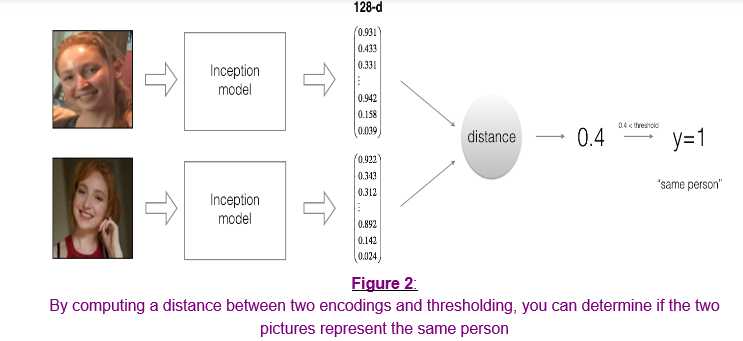标签:long params blocks relevant 阈值 ams rem region nta
from keras.models import Sequential from keras.layers import Conv2D, ZeroPadding2D, Activation, Input, concatenate from keras.models import Model from keras.layers.normalization import BatchNormalization from keras.layers.pooling import MaxPooling2D, AveragePooling2D from keras.layers.merge import Concatenate from keras.layers.core import Lambda, Flatten, Dense from keras.initializers import glorot_uniform from keras.engine.topology import Layer from keras import backend as K K.set_image_data_format(‘channels_first‘) import cv2 import os import numpy as np from numpy import genfromtxt import pandas as pd import tensorflow as tf from fr_utils import * from inception_blocks_v2 import * %matplotlib inline %load_ext autoreload %autoreload 2 np.set_printoptions(threshold=np.nan)
在人脸验证任务中,我们需要判断两张图片中的人脸是否为同一个人。最简单的做法是逐个像素点比较,如果总共的距离低于给定的某一个阈值,则判断为同一个人。这种方法效果会很差。所以我们可以通过学习一个模型,可以将人脸图片提取出特征向量,再比较特征向量的距离来判断是否为同一个人。

注意到
FRmodel = faceRecoModel(input_shape=(3, 96, 96))
print("Total Params:", FRmodel.count_params())
Result:
Total Params: 3743280

好的编码应该具有如下性质:
$triplet loss$损失函数便是描述上述性质的,并且尽量使得同一个人的两张图片的编码更加相似,不同人的两张图片的编码更具有区分性。


训练用于编码的神经网络(对应上面f映射),需要三元组图片$(A,P,N)$:
它们之间具有下式所示关系:
$$\mid \mid f(A^{(i)}) - f(P^{(i)}) \mid \mid_2^2 + \alpha < \mid \mid f(A^{(i)}) - f(N^{(i)}) \mid \mid_2^2$$
所以我们要最小化的"$triplet cost$"如下:
# GRADED FUNCTION: triplet_loss def triplet_loss(y_true, y_pred, alpha = 0.2): """ Implementation of the triplet loss as defined by formula (3) Arguments: y_true -- true labels, required when you define a loss in Keras, you don‘t need it in this function. y_pred -- python list containing three objects: anchor -- the encodings for the anchor images, of shape (None, 128) positive -- the encodings for the positive images, of shape (None, 128) negative -- the encodings for the negative images, of shape (None, 128) Returns: loss -- real number, value of the loss """ anchor, positive, negative = y_pred[0], y_pred[1], y_pred[2] ### START CODE HERE ### (≈ 4 lines) # Step 1: Compute the (encoding) distance between the anchor and the positive, you will need to sum over axis=-1 pos_dist = tf.reduce_sum(tf.square(tf.subtract(anchor, positive))) # Step 2: Compute the (encoding) distance between the anchor and the negative, you will need to sum over axis=-1 neg_dist = tf.reduce_sum(tf.square(tf.subtract(anchor, negative))) # Step 3: subtract the two previous distances and add alpha. basic_loss = tf.add(tf.subtract(pos_dist, neg_dist), alpha) # Step 4: Take the maximum of basic_loss and 0.0. Sum over the training examples. loss = tf.reduce_sum(tf.maximum(basic_loss, 0.0)) ### END CODE HERE ### return loss
with tf.Session() as test: tf.set_random_seed(1) y_true = (None, None, None) y_pred = (tf.random_normal([3, 128], mean=6, stddev=0.1, seed = 1), tf.random_normal([3, 128], mean=1, stddev=1, seed = 1), tf.random_normal([3, 128], mean=3, stddev=4, seed = 1)) loss = triplet_loss(y_true, y_pred) print("loss = " + str(loss.eval()))
Result: //和答案不一样,但我找到别人能出正确答案的代码也跟我一样,所以我认为应该是随机种子的问题
loss = 350.027
因为训练FaceNet需要大量的数据和计算,因此此作业不打算训练该模型,而是直接加载已经训练好的模型。
FRmodel.compile(optimizer = ‘adam‘, loss = triplet_loss, metrics = [‘accuracy‘]) load_weights_from_FaceNet(FRmodel)

使用方法$img_to_encoding(image_path, model)$建立一个人脸特征库,只有识别到其中的人脸才能通过验证。
database = {} database["danielle"] = img_to_encoding("images/danielle.png", FRmodel) database["younes"] = img_to_encoding("images/younes.jpg", FRmodel) database["tian"] = img_to_encoding("images/tian.jpg", FRmodel) database["andrew"] = img_to_encoding("images/andrew.jpg", FRmodel) database["kian"] = img_to_encoding("images/kian.jpg", FRmodel) database["dan"] = img_to_encoding("images/dan.jpg", FRmodel) database["sebastiano"] = img_to_encoding("images/sebastiano.jpg", FRmodel) database["bertrand"] = img_to_encoding("images/bertrand.jpg", FRmodel) database["kevin"] = img_to_encoding("images/kevin.jpg", FRmodel) database["felix"] = img_to_encoding("images/felix.jpg", FRmodel) database["benoit"] = img_to_encoding("images/benoit.jpg", FRmodel) database["arnaud"] = img_to_encoding("images/arnaud.jpg", FRmodel)
实现$verify()$方法去识别这个人是否能够通过验证,有如下几步:
# GRADED FUNCTION: verify def verify(image_path, identity, database, model): """ Function that verifies if the person on the "image_path" image is "identity". Arguments: image_path -- path to an image identity -- string, name of the person you‘d like to verify the identity. Has to be a resident of the Happy house. database -- python dictionary mapping names of allowed people‘s names (strings) to their encodings (vectors). model -- your Inception model instance in Keras Returns: dist -- distance between the image_path and the image of "identity" in the database. door_open -- True, if the door should open. False otherwise. """ ### START CODE HERE ### # Step 1: Compute the encoding for the image. Use img_to_encoding() see example above. (≈ 1 line) encoding = img_to_encoding(image_path, model) # Step 2: Compute distance with identity‘s image (≈ 1 line) dist = np.linalg.norm(encoding-database[identity]) # Step 3: Open the door if dist < 0.7, else don‘t open (≈ 3 lines) if dist<0.7: print("It‘s " + str(identity) + ", welcome home!") door_open = True else: print("It‘s not " + str(identity) + ", please go away") door_open = False ### END CODE HERE ### return dist, door_open
verify("images/camera_0.jpg", "younes", database, FRmodel)

verify("images/camera_2.jpg", "kian", database, FRmodel)

实现$who\_is\_it()$方法需要以下几步:
min_dist variable to a large enough number (100). It will help you keep track of what is the closest encoding to the input‘s encoding.for (name, db_enc) in database.items().
# GRADED FUNCTION: who_is_it def who_is_it(image_path, database, model): """ Implements face recognition for the happy house by finding who is the person on the image_path image. Arguments: image_path -- path to an image database -- database containing image encodings along with the name of the person on the image model -- your Inception model instance in Keras Returns: min_dist -- the minimum distance between image_path encoding and the encodings from the database identity -- string, the name prediction for the person on image_path """ ### START CODE HERE ### ## Step 1: Compute the target "encoding" for the image. Use img_to_encoding() see example above. ## (≈ 1 line) encoding = img_to_encoding(image_path, model) ## Step 2: Find the closest encoding ## # Initialize "min_dist" to a large value, say 100 (≈1 line) min_dist = 100 # Loop over the database dictionary‘s names and encodings. for (name, db_enc) in dataset: # Compute L2 distance between the target "encoding" and the current "emb" from the database. (≈ 1 line) dist = np.linalg.norm(encoding-db_enc) # If this distance is less than the min_dist, then set min_dist to dist, and identity to name. (≈ 3 lines) if dist < min_dist: min_dist = dist identity = name ### END CODE HERE ### if min_dist > 0.7: print("Not in the database.") else: print ("it‘s " + str(identity) + ", the distance is " + str(min_dist)) return min_dist, identity
who_is_it("images/camera_0.jpg", database, FRmodel)
虽然我们没有实现和训练神经网络,但是可以通过下面两种方法来提高算法的准确性:
https://web.stanford.edu/class/cs230/
DeepLearning.ai-Week4-Face Recognition for the Happy House
标签:long params blocks relevant 阈值 ams rem region nta
原文地址:https://www.cnblogs.com/CZiFan/p/9508338.html